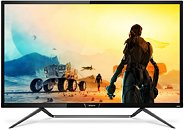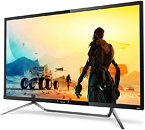Raevenlord
News Editor
- Joined
- Aug 12, 2016
- Messages
- 3,755 (1.17/day)
- Location
- Portugal
| System Name | The Ryzening |
|---|---|
| Processor | AMD Ryzen 9 5900X |
| Motherboard | MSI X570 MAG TOMAHAWK |
| Cooling | Lian Li Galahad 360mm AIO |
| Memory | 32 GB G.Skill Trident Z F4-3733 (4x 8 GB) |
| Video Card(s) | Gigabyte RTX 3070 Ti |
| Storage | Boot: Transcend MTE220S 2TB, Kintson A2000 1TB, Seagate Firewolf Pro 14 TB |
| Display(s) | Acer Nitro VG270UP (1440p 144 Hz IPS) |
| Case | Lian Li O11DX Dynamic White |
| Audio Device(s) | iFi Audio Zen DAC |
| Power Supply | Seasonic Focus+ 750 W |
| Mouse | Cooler Master Masterkeys Lite L |
| Keyboard | Cooler Master Masterkeys Lite L |
| Software | Windows 10 x64 |
MMD, the leading technology company and brand release partner for Philips monitors, is proud to announce its recently launched Philips 436M6VBPAB was confirmed by Video Electronics Standards Association (VESA) as the first display to be officially certified for the DisplayHDR 1000 specification, capable of delivering a profoundly new viewing experience, thanks to striking brightness, deeper contrast and vibrant colours. The new Philips Momentum Line has already been honored with the Computex d & I Award 2017 by IF and Red Dot guru award: Product Design 2017 for its eye-catching and innovative design. It now proudly includes among its achievements the world-renowned VESA DisplayHDR 1000 and UHDA certification, which confirm MMD's commitment to delivering innovative products capable of satisfying even the most demanding segments of the market.


The opportunity was provided by the announcement of VESA's DisplayHDR Test-Pro, a new test tool that enables users to validate display capabilities, including brightness, colour and contrast performance of laptop and desktop High Dynamic Range (HDR) displays, based on VESA's high performance compliance testing specifications. To date, nearly a dozen displays have been certified under the new spec across the three performance levels (DisplayHDR 400, 600 and 1000) and released to the market. Parameters requirements comprise three peak luminance tests, two contrast measurement tests, colour testing of the BT.709 and DCI-P3 colour gamuts, bit-depth requirement test and HDR response performance test. Only Philips 436M6VBPAB achieved maximum tier so far, by satisfying requirements of 8+2bit, BT. 709 99%, DCI-P3 90%, Brightness (Center Peak) 1000 nits, Brightness (Full Frame) 600 nits and Dark 0.05 nits.
"Achieving this standard confirms MMD's commitment to providing state-of-the-art technology for an ever-growing customer base, now reaching entertainment and console gaming users," commented Stefan Sommer, Director of Marketing & Business Management Europe at MMD. "The Momentum line-up fills the gap in the Philips monitors' product range and we're very excited to have unveiled the world's first DisplayHDR 1000 display to offer a more immersive visual experience."


The monitor designed for the gaming console is being noticed thanks to its remarkable features, such as 4K UHD resolution 3,840 x 2,160 pixels @ 60 Hz, 4 ms GtG response time with SmartResponse and Adaptive Sync technology combined to Low Input Lag ensure a smooth gameplay even in the fast-paced gameplay. Quantum Dot Technology and Ultra-Wide Color deliver 97.6% of the DCI and 103% of NTSC gamut, 103,64 PPI, C/R is equal to 4000:1 and the already mentioned brightness reach impressive 1000 nit. Ambiglow adaptive lighting, MultiView function, DTS Sound audio and the remote control makes it a perfect place for home entertainment.
Pricing will sit at an 849,- to 899,- EUR/USD level.
View at TechPowerUp Main Site


The opportunity was provided by the announcement of VESA's DisplayHDR Test-Pro, a new test tool that enables users to validate display capabilities, including brightness, colour and contrast performance of laptop and desktop High Dynamic Range (HDR) displays, based on VESA's high performance compliance testing specifications. To date, nearly a dozen displays have been certified under the new spec across the three performance levels (DisplayHDR 400, 600 and 1000) and released to the market. Parameters requirements comprise three peak luminance tests, two contrast measurement tests, colour testing of the BT.709 and DCI-P3 colour gamuts, bit-depth requirement test and HDR response performance test. Only Philips 436M6VBPAB achieved maximum tier so far, by satisfying requirements of 8+2bit, BT. 709 99%, DCI-P3 90%, Brightness (Center Peak) 1000 nits, Brightness (Full Frame) 600 nits and Dark 0.05 nits.
"Achieving this standard confirms MMD's commitment to providing state-of-the-art technology for an ever-growing customer base, now reaching entertainment and console gaming users," commented Stefan Sommer, Director of Marketing & Business Management Europe at MMD. "The Momentum line-up fills the gap in the Philips monitors' product range and we're very excited to have unveiled the world's first DisplayHDR 1000 display to offer a more immersive visual experience."


The monitor designed for the gaming console is being noticed thanks to its remarkable features, such as 4K UHD resolution 3,840 x 2,160 pixels @ 60 Hz, 4 ms GtG response time with SmartResponse and Adaptive Sync technology combined to Low Input Lag ensure a smooth gameplay even in the fast-paced gameplay. Quantum Dot Technology and Ultra-Wide Color deliver 97.6% of the DCI and 103% of NTSC gamut, 103,64 PPI, C/R is equal to 4000:1 and the already mentioned brightness reach impressive 1000 nit. Ambiglow adaptive lighting, MultiView function, DTS Sound audio and the remote control makes it a perfect place for home entertainment.
Pricing will sit at an 849,- to 899,- EUR/USD level.
View at TechPowerUp Main Site



 Then again their TVs were never great apart from Ambilight which is a pretty neat feature.
Then again their TVs were never great apart from Ambilight which is a pretty neat feature.

